Native plants are significant despite being frequently disregarded and undervalued. Gardeners often ignore natural plants because they appear too ordinary or uninteresting. In actuality, every native plant has its special traits and advantages that give the gardener something natural and fresh.
Minnesota is home to hundreds of different natural plant species. As a result, some of America’s most significant collections of native flora are found in this state.
Any landscape would benefit from the addition of native plants. They are versatile and offer various colors, bloom duration, patterns, and textures. Additionally, they are relied upon by insects, animals, and a significant number of pollinators.
Today, we discover 12 of Minnesota’s top native plants:
1. The Hoary Puccoon (Lithospermum canescens)
This flower offers something a little unusual and different. The single, short-stalked flowers, which range in height from six to 18 inches, have a brilliant yellow-orange color. Tubular, petal-like lobes encircle the little centers.
When it is blooming, bees, butterflies, and other insects will swarm it. It grows in grasslands, savannas, woods, and meadows in the wild.
The stalkless, narrow, lance-oblong leaves can grow up to three inches long and 12 inches wide. Leaf edges are toothed, hairy, and more thickly and softly haired on the underside than the upper surface.
In addition to the flowers being thick from the base, their stems are usually unbranched and coated in long, velvety, gray hairs.

The hoary pucoon (
Lithospermum canescens) has brilliant yellow-orange color flowers.
©K Hanley CHDPhoto/Shutterstock.com
2. The Viper’s Bugloss (Echium vulgare)
The biennial weed known as the viper’s bugloss can reach heights of up to three feet. Blue to purple blooms, and occasionally pink or white, are formed by the elongating clusters near the stem’s apex.
The flowers, which are funnel or bell-shaped and typically 12 to 34 inches long, bloom from June to September and are borne in clusters at the stem’s apex. It is a food source for honeybees and possibly other pollinators as well.
These plants contain alkaloids known to be harmful to horses and other animals. Because of its distinctive appearance, the viper’s bugloss cannot be confused with other wildflowers.
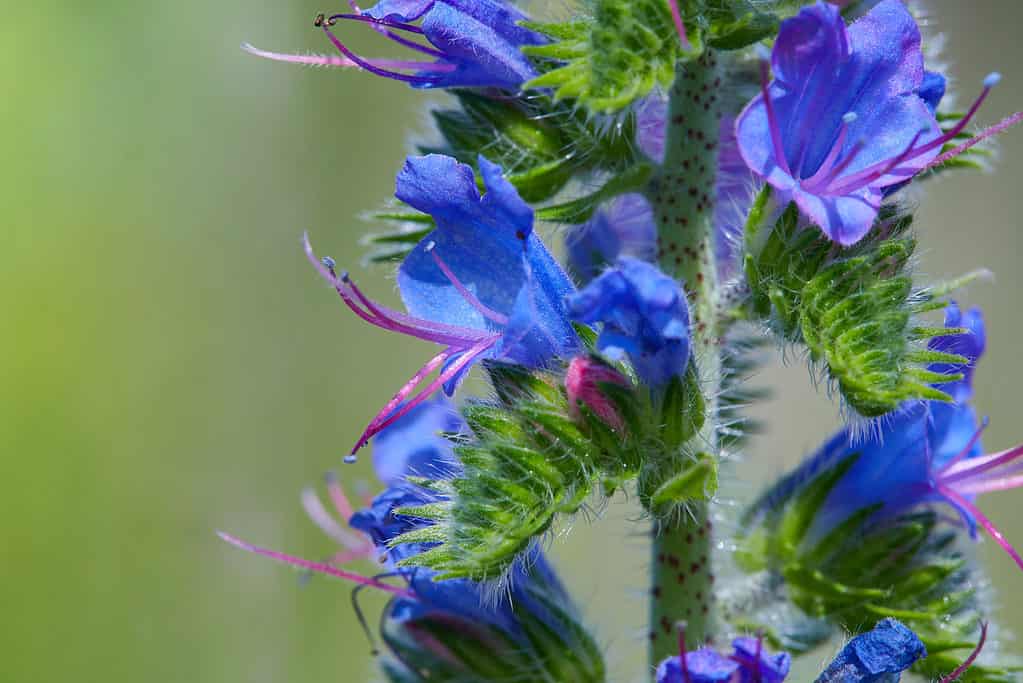
Viper’s bugloss (
Echium vulgare) has blue to purple blooms which are funnel or bell-shaped.
©iStock.com/Liudmyla Liudmyla
3. The Tall Blazing Star (Liatris aspera)
A tall blazing star’s blooms appear in a spike-like clump that is six to 18 inches long and has a shape resembling a star. This perennial can grow up to four feet tall and has pink to purple blooms from July to September.
Also known as the rough blazing star or gayfeather, the tall blazing star is a common avian species. This flower grows natively in Minnesota’s open woodlands, along roads, and arid plains, where it prefers part shade to full sun.
Stem leaves are typically three inches long, slender, and blade-like, with a noticeable center vein and pointy tip. Basal and lower stem leaves can be up to 12 inches long, less shaped like grass, and have long stalks.
As the stem ascends, the leaves become smaller, narrower, and stalkless. They often wither away by flowering time.
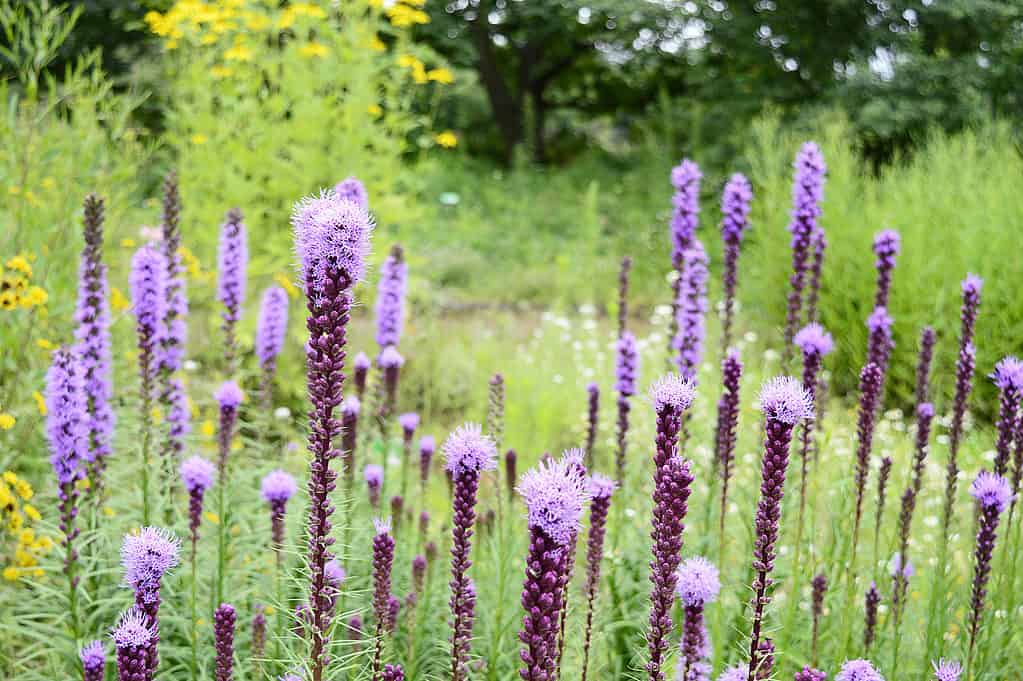
Tall blazing star (
Liatris aspera) has blooms which appear in a spike-like clump, six to 18 inches long, with a shape resembling a star.
©iStock.com/agatchen
4. The Prairie Phlox (Phlox pilosa)
The prairie phlox will reach a mature height of around 18 inches and a spread of 24 inches with the flowers. Individual plants must be spaced roughly 20 inches apart, whether grown in groups or as bedding plants.
The plant has a medium growth rate and a maximum estimated life span of 10 years in a perfect environment. Full sun to partial shade environment is ideal for this plant. It thrives in moderate to equally moist conditions but cannot stand still water.
Regarding pH and soil type, the prairie phlox is not picky. It has a very high tolerance for smog and may even survive in densely populated areas. This species is indigenous to most parts of North America.

Prairie phlox (
Phlox pilosa) produces showy pink flowers and is indigenous to most parts of North America.
©ChWeiss/Shutterstock.com
5. The Heath Aster (Symphyotrichum ericoides)
Native to North America, the white heath aster is a herbaceous perennial classified in the Aster family. This plant requires between one and three feet of space and typically grows in arid, open settings.
The numerous small, stiff, heath-like leaves contribute to the plant’s thick multi-stem structure. In addition, the plant is covered in tiny, white, multi-petaled composite flowers from summer into fall, adding some late-season beauty to the landscape.
The plant’s leaves and flowers are edible, either fresh or dried. But they are commonly used as a garnish in salads and herbal teas. Moreover, the plant has many health benefits and was traditionally used to treat diarrhea, fevers, pain, and weak skin.

Heath aster (
Symphyotrichum ericoides) is covered in tiny, white, multi-petaled composite flowers from summer into fall.
©BaniHasyim/Shutterstock.com
6. The Maiden Pink (Dianthus deltoides)
The maiden pink is a weed species that produces stunning, eye-catching pink flowers that are generally solitary but can occasionally bloom in clusters of two to four at the tip of the stems. The plant develops at four to 16 inches from June to August.
The soil should be well drained to allow adequate nourishment. Since maiden pinks prefer partial to full sun, they may be discovered in the wild at the sides of roads, in open clearings, abandoned fields, and trail borders.
You will likely notice this blossom in your yard, and butterflies and bees will also be drawn to it.
The toothless, hairless, or minutely hairy leaves can be up to two inches long and less than 1/8 inch broad. They are lance-shaped, taper to a blunt or pointed tip, and bulge at the leaf node at which a set of opposite leaves connect the stem.

Maiden pink (
Dianthus deltoides) can be found at the sides of roads, in open clearings, abandoned fields, and trail borders in areas of Minnesota.
©iStock.com/ANGHI
7. The Trailing Pea (Strophostyles leiosperma)
Slick-seed fuzzy bean, little fuzzy bean, and smooth-seed wild bean are some of the most common names for the trailing pea. The usual height of this natural vining plant is between 12 and 30 inches. A thin, hairy stalk is topped with clusters of two to six pea-shaped blooms.
Wild beans and trailing peas have a close relationship. It prefers dry or damp sandy soil and blooms from August to September.
Leaflets of three are arranged in bunches on thin stems. Some of the characteristics of the plant’s leaflets include:
- They are one to two inches long
- They are roughly oval to egg-shaped
- They are rounded at the base
- They have a tapering to a pointy tip
- They are sparsely haired
The laterals are asymmetrical at the base and the end, stalkless, and may contain shallow lobes. The end leaflet is stalked.
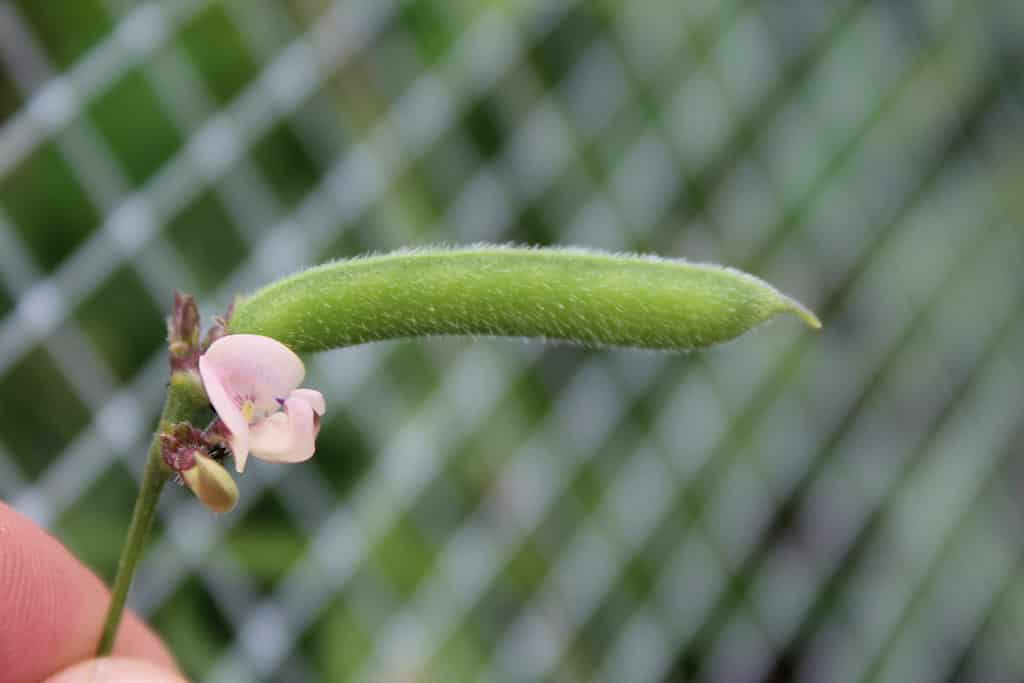
Trailing pea (
Strophostyles leiosperma) is also known as slick-seed fuzzy bean, little fuzzy bean, and smooth-seed wild bean.
©Windscorpion, CC BY-SA 4.0 <https://creativecommons.org/licenses/by-sa/4.0>, via Wikimedia Commons – Original / License
8. The Louisiana Lettuce (Lactuca ludoviciana)
The Louisiana lettuce is also referred to as prairie or wild lettuce from the west. Plains, grasslands, meadows, and woodland openings have this short-lived perennial.
This flower blooms at one to five feet high from June to September. The stalked blooms grow in open, branching clusters at the top of the plant, giving it a distinctive appearance. They can occasionally be yellow but are typically purple, lavender, or pink.
The plant’s lower leaves are highly lobed and coarsely serrated with sharp, pointed teeth and can reach up to 12 inches long and eight inches wide.
As the stem ascends, the leaves get smaller and less lobbed. The upper stem leaves are about two inches wide, four inches long, and unlobed. The base of leaves often has two broad lobes, or “auricles,” and are stalkless. Their color is typically green to blue-green.
9. The Lavender Hyssop (Agastache foeniculum)
From mid-summer to mid-fall, the lavender hyssop blooms profusely in masses on gorgeous spikes that rise above the foliage. These flowers are most effective when planted in clusters.
The blossoms make excellent cut flowers. Their lovely, fragrant, pointed leaves are dark green all season long.
This herbaceous perennial native plant grows in an upright, spreading manner. Although its medium texture fits into the environment, it may always be countered by a few finer or coarser plants for a successful composition.
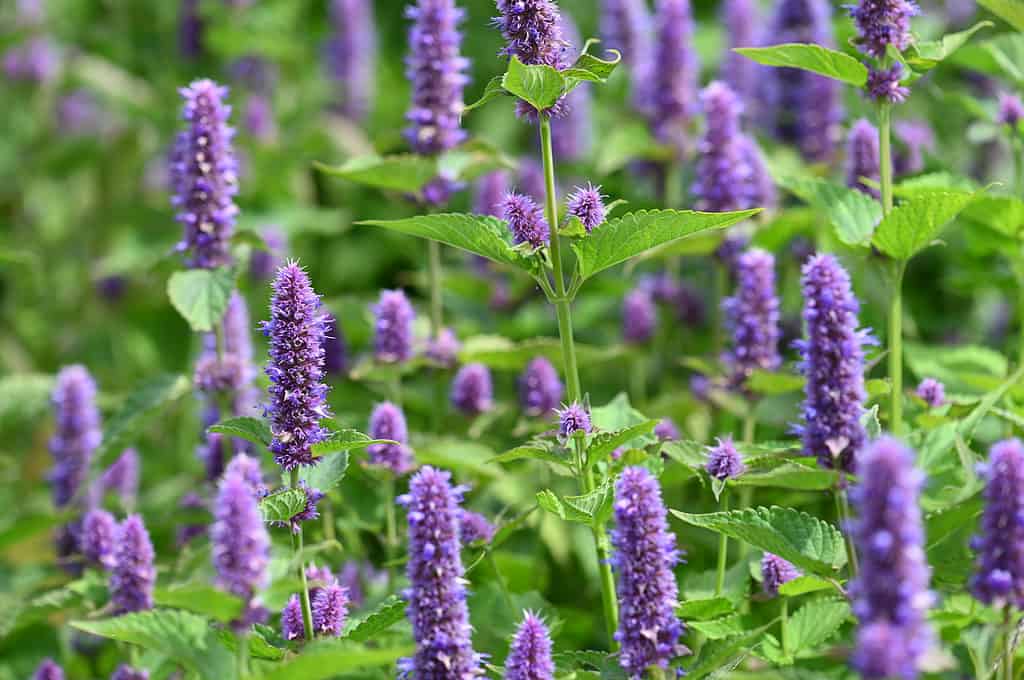
blooms profusely in masses on gorgeous spikes that rise above the foliage.
©iStock.com/BethAmber
10. The Prairie Onion (Allium stellatum)
A pink-flowered perennial prairie onion blooms from July through August. It prefers dry fields and prairies with full sun, allowing it to grow to a height range of eight to 18 inches.
The plant’s other names include the wild prairie onion, pink wild onion, and autumn onion.
This plant’s flowers grow in one-and-a-half to two-inch circular clusters with one-inch flowers, making it relatively simple to take care of. Their color ranges from light pink to dark pinkish purple. They can be distinguished from related wildflowers by their tail of yellow-tipped stamens.
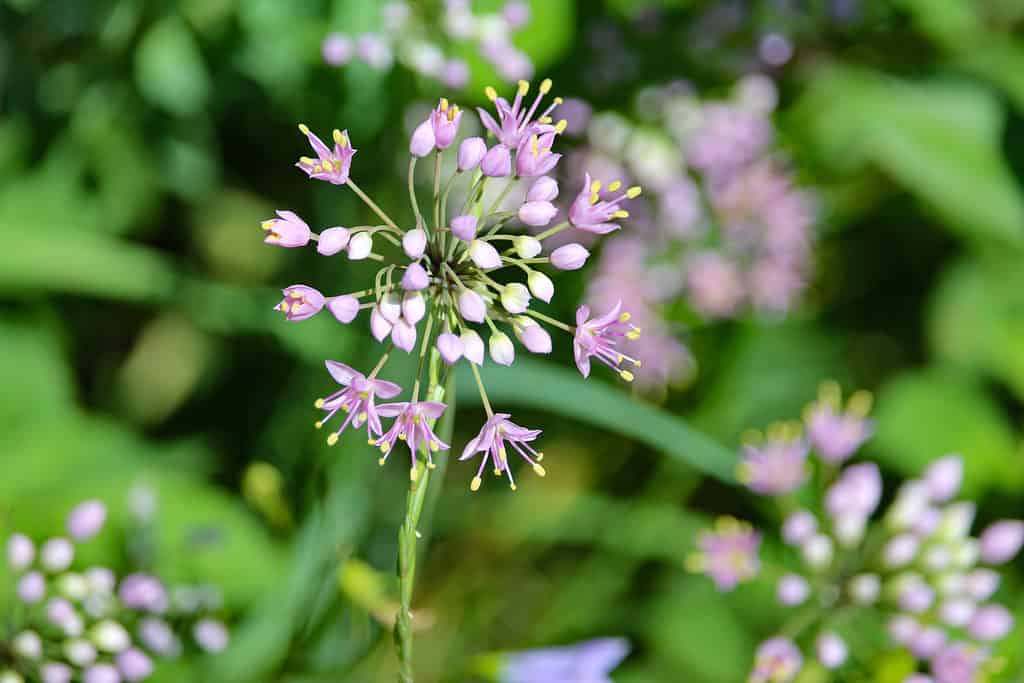
The prairie onion (
Allium stellatum) can be distinguished from related wildflowers by their yellow-tipped stamens.
©iStock.com/Jerrold James Griffith
11. The Culver’s Root (Veronicastrum virginicum)
From late summer to mid-fall, the Culver’s root produces a profusion of stunning spikes of white flowers that rise above the foliage. These flowers are most striking when planted in groups. The flowers make lovely bouquets.
The plant has slender leaves that are dark green all season long. When fully grown, the Culver’s root reaches a height of three feet, with the potential to reach four feet with the flowers and a three-foot spread.
Individual plants should be spaced roughly 30 inches apart when grown in groups or used as bedding plants. The Culver’s root has to be underplanted with shorter perennials due to its tendency to be lanky, with a typical clearance of one foot off the ground. Further, it expands quickly, and given the right circumstances, one can anticipate a life span of roughly ten years.
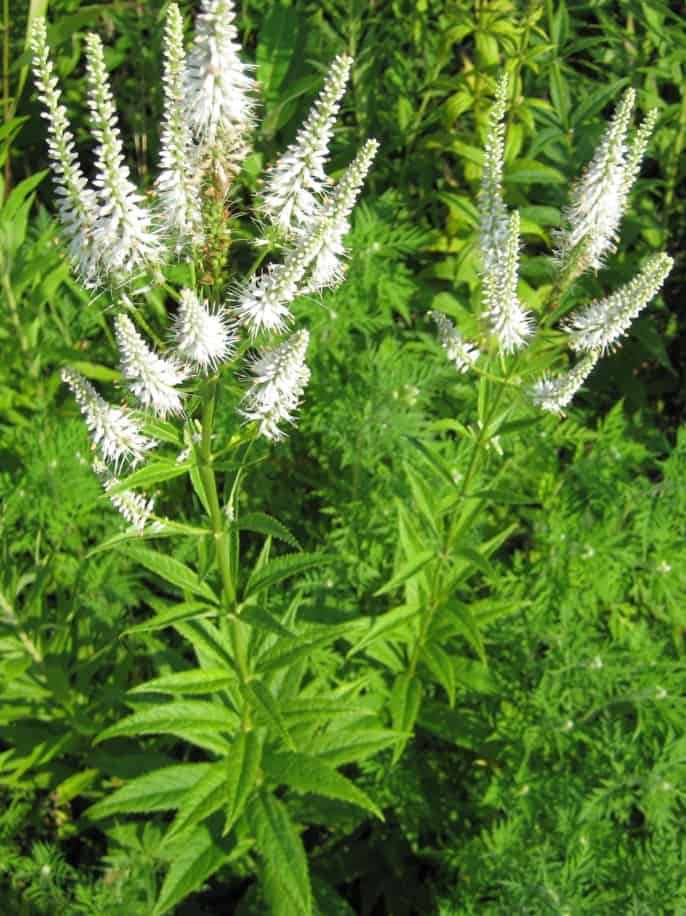
Culver’s root (
Veronicastrum virginicum) produces a profusion of stunning spikes of white flowers.
©Crazytwoknobs, CC BY 3.0 <https://creativecommons.org/licenses/by/3.0>, via Wikimedia Commons – Original / License
12. The Kobold Blazing Star (Liatris spicata)
From mid-summer to early fall, the Kobold blazing star produces gorgeous spikes of violet flowers that rise above the leaves. These flowers are most stunning when planted in groups.
The blooms make excellent cut flowers. Its grassy leaves maintain their green tint all year round. This native plant also has fruits. However, they have no noteworthy decorative qualities.
At maturity, the Kobold blazing star grows 12 inches tall. When blooming, it can grow 30 inches tall with a spread of 18 inches. It has a rapid growth rate and, in ideal circumstances, a lifespan of around ten years.
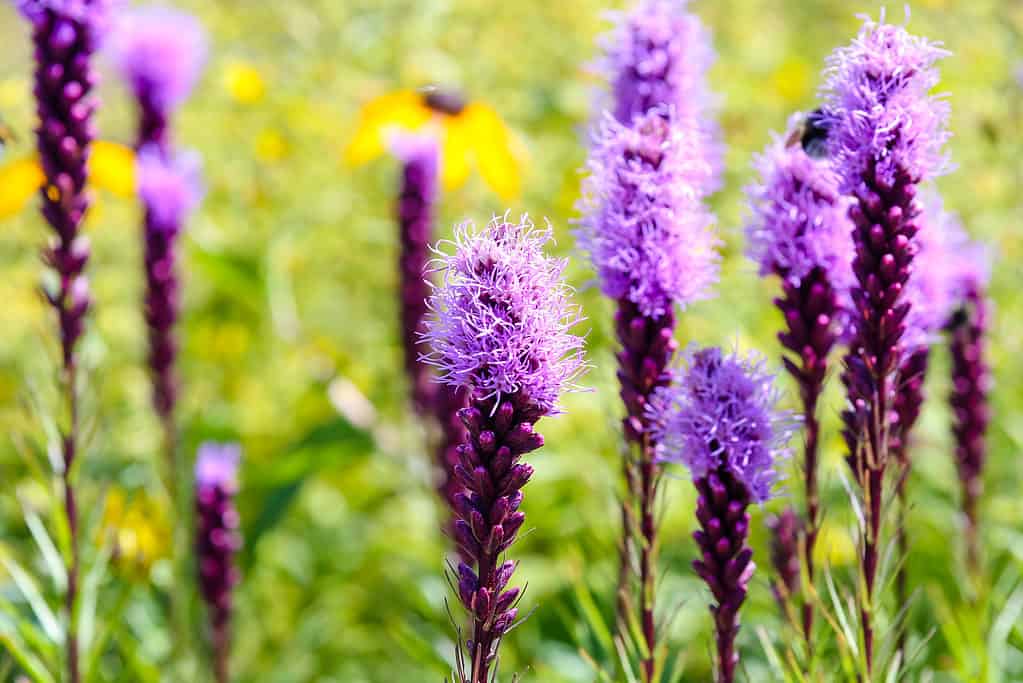
Kobold blazing star (
Liatris spicata) produces gorgeous spikes of violet flowers.
©iStock.com/todamo
Summary of the 12 Native Plants in Minnesota
Here are the 12 Native Plants in Minnesota:
| Rank | Native Plants |
|---|---|
| 1 | The Hoary Puccoon (Lithospermum canescens) |
| 2 | The Viper’s Bugloss (Echium vulgare) |
| 3 | The Tall Blazing Star (Liatris aspera) |
| 4 | The Prairie Phlox (Phlox pilosa) |
| 5 | The Heath Aster (Symphyotrichum ericoides) |
| 6 | The Maiden Pink (Dianthus deltoides) |
| 7 | The Trailing Pea (Strophostyles leiosperma) |
| 8 | The Louisiana Lettuce (Lactuca ludoviciana) |
| 9 | The Lavender Hyssop (Agastache foeniculum) |
| 10 | The Prairie Onion (Allium stellatum) |
| 11 | The Culver’s Root (Veronicastrum virginicum) |
| 12 | The Kobold Blazing Star (Liatris spicata) |
Key Takeaways
North America’s most beautiful scenery can be found in Minnesota. Visitors can enjoy a wide range of natural treasures in the state, from majestic lakes to infinite forests. In addition, there are lovely parks, rivers, and paths where nature lovers can unwind.
While bees, birds, and butterflies come to mind as the most apparent pollinators, these plants can also serve as homes for other small, warm-blooded animals and microscopic organisms in the soil. These living entities have tasks, and the natural world encourages symbiotic relationships.
Further, native plants are excellent choices for landscaping. They need significantly fewer pesticides, fertilizer, and watering.
Thank you for reading! Have some feedback for us? Contact the AZ Animals editorial team.








